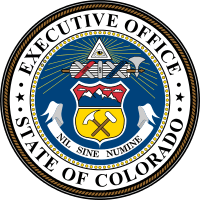Governor of Colorado
| Governor of the State of Colorado | |
|---|---|
|
| |
| Style | The Honorable |
| Residence | Colorado Governor's Mansion |
| Term length | Four years, can succeed self once |
| Inaugural holder | John Long Routt |
| Formation | August 1, 1876 |
| Deputy | Donna Lynne |
| Salary | $90,000 (2013)[1] |
| Website | www.colorado.gov/governor |
The Governor of the State of Colorado is the head of the executive branch of Colorado's state government and the commander-in-chief of the state's military forces. The governor has a duty to enforce state laws, and the power to either approve or veto bills passed by the Colorado General Assembly, to convene the legislature, and to grant pardons, except in cases of treason or impeachment.[2]
Seven people served as governor of Colorado Territory over eight terms, appointed by the President of the United States. Since statehood, there have been 36 governors, serving 41 distinct terms. The longest-serving governors were Richard "Dick" Lamm and Roy Romer, who each served twelve years over three terms. The shortest term occurred on March 17, 1905, a day when the state had three governors: Alva Adams won the election, but soon after he took office, the legislature declared his opponent, James Peabody, governor, but on the condition that he immediately resign, so that his lieutenant governor, Jesse McDonald, could be governor. Thus, Peabody served only a few minutes as governor.
The current governor is John Hickenlooper, who took office on January 11, 2011.
Governors
Governor of the Territory of Jefferson
The self-proclaimed Provisional Government of the Territory of Jefferson was organized on November 7, 1859.[3] Jefferson Territory included all of present-day Colorado, but extended about 3 miles (5 km) farther east, 138 miles (222 km) farther north, and about 50 miles (80 km) farther west.[4] The territory was never recognized by the federal government in the tumultuous days before the American Civil War. The Jefferson Territory had only one governor, Robert Williamson Steele, a pro-union Democrat elected by popular vote. He proclaimed the territory dissolved on June 6, 1861, several months after the official formation of the Colorado Territory, but only days after the arrival of its first governor.[5]
Governors of the Territory of Colorado
- For the period before Colorado Territory was formed, see the lists of Governors of New Mexico Territory, Utah Territory, Kansas Territory, and Nebraska Territory.
The Territory of Colorado was organized on February 28, 1861, from parts of the territories of New Mexico, Utah, and Nebraska, and the unorganized territory that was previously the western portion of Kansas Territory.[6]
| # | Portrait | Governor | Term in office | Appointed by |
|---|---|---|---|---|
| 1 | .jpg) |
William Gilpin | March 25, 1861[7][lower-alpha 1] – March 26, 1862[lower-alpha 2] | Abraham Lincoln |
| 2 | 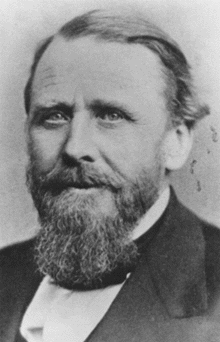 |
John Evans | March 26, 1862[7] – October 17, 1865[lower-alpha 3] | |
| 3 |  |
Alexander Cummings | October 17, 1865[11] – April 24, 1867 | Andrew Johnson |
| 4 |  |
Alexander Cameron Hunt | April 24, 1867[11] – June 14, 1869 | |
| 5 | 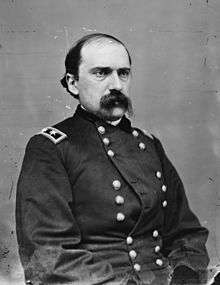 |
Edward M. McCook | June 14, 1869[12] – Sometime in 1873[lower-alpha 4] | Ulysses S. Grant |
| 6 | 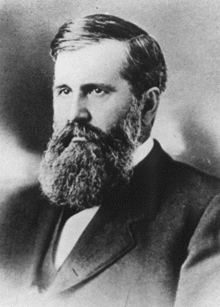 |
Samuel Hitt Elbert | April 4, 1873[13] – Sometime in 1874[lower-alpha 5] | |
| 7 |  |
Edward M. McCook | June 19, 1874[12] – March 29, 1875 | |
| 8 |  |
John Long Routt | March 29, 1875[14] – August 1, 1876 |
Governors of the State of Colorado
The State of Colorado was admitted to the Union on August 1, 1876.
To serve as governor, one must be at least 30 years old, be a citizen of the United States, and have been a resident of the state for at least two years prior to election. The state constitution of 1876 originally called for election of the governor every two years, with their term beginning on the second Tuesday of the January following the election.[15] An amendment passed in 1956, taking effect in 1959, increased terms to four years.[16] Originally, there was no term limit applied to the governor; a 1990 amendment allowed governors to succeed themselves only once.[17] There is however no limit on the total number of terms one may serve as long as one who has served the two term limit is out of office for four years.
Should the office of governor become vacant, the lieutenant governor becomes governor.[18] If both the offices governor and lieutenant governor are vacant, the line of succession moves down through the senior members of the state senate and state house of representatives of the same party as the governor.[19] The lieutenant governor was elected separately from the governor until a 1968 amendment to the constitution[20] made it so that they are elected on the same ticket.[21]
| #[lower-alpha 6] | Governor | Term in office | Party | Term[lower-alpha 7] | Lt. Governor[lower-alpha 8] | |||
|---|---|---|---|---|---|---|---|---|
| 1 |  |
John Long Routt | August 1, 1876 – January 14, 1879 | Republican | 1 (1876) |
Lafayette Head | ||
| 2 |  |
Frederick Walker Pitkin | January 14, 1879 – January 9, 1883 | Republican | 2 (1878) |
Horace Austin Warner Tabor | ||
| 3 (1880) | ||||||||
| 3 |  |
James Benton Grant | January 9, 1883 – January 13, 1885 | Democratic | 4 (1882) |
William H. Meyer[lower-alpha 9] | ||
| 4 |  |
Benjamin Harrison Eaton | January 13, 1885 – January 11, 1887 | Republican | 5 (1884) |
Peter W. Breene | ||
| 5 |  |
Alva Adams | January 11, 1887 – January 8, 1889 | Democratic | 6 (1886) |
Norman H. Meldrum | ||
| 6 | 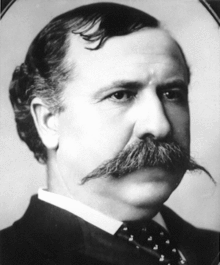 |
Job Adams Cooper | January 8, 1889 – January 13, 1891 | Republican | 7 (1888) |
William Grover Smith | ||
| 7 |  |
John Long Routt | January 13, 1891 – January 10, 1893 | Republican | 8 (1890) |
William Story | ||
| 8 | 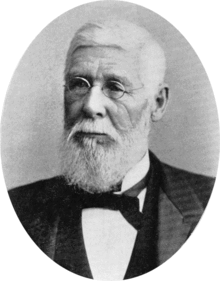 |
Davis Hanson Waite | January 10, 1893 – January 8, 1895 | People's | 9 (1892) |
David Hopkinson Nichols | ||
| 9 | 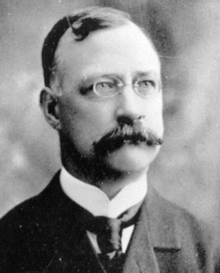 |
Albert Washington McIntire | January 8, 1895 – January 12, 1897 | Republican | 10 (1894) |
Jared L. Brush[lower-alpha 9] | ||
| 10 |  |
Alva Adams | January 12, 1897 – January 10, 1899 | Democratic | 11 (1896) | |||
| 11 | 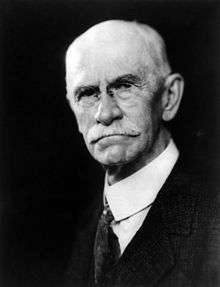 |
Charles Spalding Thomas | January 10, 1899 – January 8, 1901 | Democratic | 12 (1898) |
Francis Patrick Carney[lower-alpha 10] | ||
| 12 |  |
James Bradley Orman | January 8, 1901 – January 13, 1903 | Democratic | 13 (1900) |
David C. Coates[lower-alpha 11] | ||
| 13 |  |
James Hamilton Peabody | January 13, 1903 – January 10, 1905 | Republican | 14 (1902) |
Warren A. Haggott[lower-alpha 12] | ||
| 14 |  |
Alva Adams | January 10, 1905 – March 17, 1905 | Democratic | 15 (1904) [lower-alpha 13] |
Arthur Cornforth | ||
| 15 |  |
James Hamilton Peabody | March 17, 1905 – March 17, 1905 | Republican | Jesse Fuller McDonald | |||
| 16 |  |
Jesse Fuller McDonald | March 17, 1905 – January 8, 1907 | Republican | Vacant | |||
| Fred W. Parks (took office July 5, 1905) | ||||||||
| 17 | 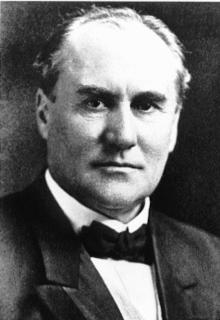 |
Henry Augustus Buchtel | January 8, 1907 – January 12, 1909 | Republican | 16 (1906) |
Erastus Harper | ||
| 18 | 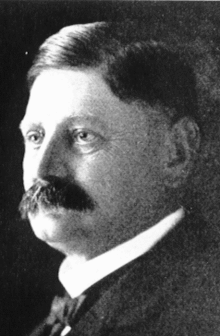 |
John F. Shafroth | January 12, 1909 – January 14, 1913 | Democratic | 17 (1908) |
Stephen R. Fitzgarrald | ||
| 18 (1910) | ||||||||
| 19 |  |
Elias M. Ammons | January 14, 1913 – January 12, 1915 | Democratic | 19 (1912) | |||
| 20 |  |
George Alfred Carlson | January 12, 1915 – January 9, 1917 | Republican | 20 (1914) |
Moses E. Lewis | ||
| 21 |  |
Julius Caldeen Gunter | January 9, 1917 – January 14, 1919 | Democratic | 21 (1916) |
James A. Pulliam | ||
| 22 |  |
Oliver Henry Shoup | January 14, 1919 – January 9, 1923 | Republican | 22 (1918) |
George Stepham | ||
| 23 (1920) |
Earl Cooley | |||||||
| 23 |  |
William Ellery Sweet | January 9, 1923 – January 13, 1925 | Democratic | 24 (1922) |
Robert F. Rockwell[lower-alpha 9] | ||
| 24 |  |
Clarence Morley | January 13, 1925 – January 11, 1927 | Republican | 25 (1924) |
Sterling Byrd Lacy[lower-alpha 14] | ||
| 25 |  |
Billy Adams | January 11, 1927 – January 10, 1933 | Democratic | 26 (1926) |
George Milton Corlett[lower-alpha 9] | ||
| 27 (1928) | ||||||||
| 28 (1930) |
Edwin C. Johnson | |||||||
| 26 |  |
Edwin C. Johnson | January 10, 1933 – January 1, 1937 | Democratic | 29 (1932) |
Ray Herbert Talbot | ||
| 30 (1934) [lower-alpha 15] | ||||||||
| 27 |  |
Ray Herbert Talbot | January 1, 1937 – January 12, 1937 | Democratic | Vacant | |||
| 28 |  |
Teller Ammons | January 12, 1937 – January 10, 1939 | Democratic | 31 (1936) |
Frank J. Hayes | ||
| 29 | 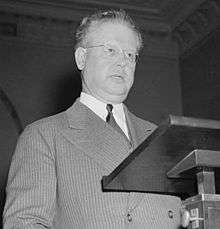 |
Ralph Lawrence Carr | January 10, 1939 – January 12, 1943 | Republican | 32 (1938) |
John Charles Vivian | ||
| 33 (1940) | ||||||||
| 30 |  |
John Charles Vivian | January 12, 1943 – January 14, 1947 | Republican | 34 (1942) |
William Eugene Higby | ||
| 35 (1944) | ||||||||
| 31 |  |
William Lee Knous | January 14, 1947 – April 15, 1950 | Democratic | 36 (1946) |
Homer L. Pearson | ||
| 37 (1948) [lower-alpha 16] |
Walter Walford Johnson | |||||||
| 32 |  |
Walter Walford Johnson | April 15, 1950 – January 9, 1951 | Democratic | Charles P. Murphy[lower-alpha 9] | |||
| 33 |  |
Daniel I.J. Thornton | January 9, 1951 – January 11, 1955 | Republican | 38 (1950) |
Gordon L. Allott | ||
| 39 (1952) | ||||||||
| 34 |  |
Edwin C. Johnson | January 11, 1955 – January 8, 1957 | Democratic | 40 (1954) |
Stephen L.R. McNichols | ||
| 35 |  |
Stephen L.R. McNichols | January 8, 1957 – January 8, 1963 | Democratic | 41 (1956) |
Frank L. Hays[lower-alpha 9] | ||
| 42 (1958) [lower-alpha 17] |
Robert Lee Knous | |||||||
| 36 | 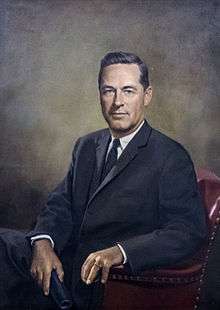 |
John Arthur Love | January 8, 1963 – July 16, 1973 | Republican | 43 (1962) | |||
| 44 (1966) |
Mark Anthony Hogan[lower-alpha 14] | |||||||
| 45 (1970) [lower-alpha 18] |
John David Vanderhoof | |||||||
| 37 |  |
John David Vanderhoof | July 16, 1973 – January 14, 1975 | Republican | Ted L. Strickland | |||
| 38 |  |
Richard "Dick" Lamm | January 14, 1975 – January 13, 1987 | Democratic | 46 (1974) |
George L. Brown | ||
| 47 (1978) |
Nancy E. Dick | |||||||
| 48 (1982) | ||||||||
| 39 | 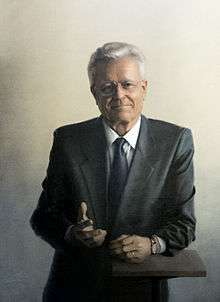 |
Roy Romer | January 13, 1987 – January 12, 1999 | Democratic | 49 (1986) |
Mike Callihan (resigned May 10, 1994) | ||
| 50 (1990) | ||||||||
| Vacant | ||||||||
| Samuel H. Cassidy (took office May 11, 1994) | ||||||||
| 51 (1994) |
Gail Schoettler | |||||||
| 40 |  |
Bill Owens | January 12, 1999 – January 9, 2007 | Republican | 52 (1998) |
Joe Rogers | ||
| 53 (2002) |
Jane E. Norton | |||||||
| 41 |  |
Bill Ritter | January 9, 2007 – January 11, 2011 | Democratic | 54 (2006) |
Barbara O'Brien | ||
| 42 | John Hickenlooper | January 11, 2011 – Incumbent | Democratic | 55 (2010) |
Joseph A. Garcia (resigned May 12, 2016) | |||
| 56 (2014) [lower-alpha 19] | ||||||||
| Donna Lynne | ||||||||
Living former governors
There are four living former governors of Colorado, the oldest being Roy Romer (served 1987–1999, born 1928). The most recent death of a former governor was that of John David Vanderhoof (served 1973–1975, born 1922), who died on September 19, 2013.
| Governor | Gubernatorial term | Date of birth (and age) |
|---|---|---|
| Richard "Dick" Lamm | 1975–1987 | September 12, 1935 |
| Roy Romer | 1987–1999 | October 31, 1928 |
| Bill Owens | 1999–2007 | October 22, 1950 |
| Bill Ritter | 2007–2011 | September 6, 1956 |
See also
- Outline of Colorado
- Index of Colorado-related articles
- State of Colorado
- Law and government of Colorado
- Governor of Colorado
- Law and government of Colorado
Notes
- ↑ The territory was formed on February 28, 1861, but no governor was appointed until March 25, 1861. Gilpin himself did not arrive in the territory until May 27, 1861.[8]
- ↑ Removed from office for improper financial drafts from the federal treasury.[9]
- ↑ Resigned at the request of President Johnson following the Sand Creek Massacre. The resignation was requested on July 18, 1865.[10]
- ↑ Removed from office by petition.[12]
- ↑ Records show Elbert served "less than a year", but his successor was appointed on June 19, 1874, which was 14 months after Elbert took office.[13]
- ↑ The official numbering includes repeat governors.
- ↑ Each term for which a governor is elected is listed here; if multiple governors served in a single term, due to resignations, deaths, and the like, then that term will be shared among those governors. If a governor was elected multiple times, then there will be multiple terms listed for that governor.
- ↑ Lieutenant governors represented the same party as their governor unless noted.
- 1 2 3 4 5 6 Represented the Republican Party.
- ↑ Represented the Populist Party.
- ↑ The Colorado State Archives labels Coates a Democrat;[22] however, a contemporary New York Times article describes him as a Populist elected on a fusion ticket, and that he had renounced all other parties and become a Socialist.[23]
- ↑ The Colorado State Archives says Haggott served from 1902 to 1903; however, multiple sources say he served with Peabody[24] well into 1904,[25] so it is assumed the Archives are in error.
- ↑ The 1904 election was rife with fraud and controversy. Alva Adams won election, but soon after he took office the Republican legislature declared James Peabody to be the actual winner, on the condition that Peabody immediately resign. Since Peabody had been governor for a few moments before resigning, it was his lieutenant governor, Jesse McDonald, that succeeded to the governorship. In all, Colorado had three governors on March 17, 1905.
- 1 2 Represented the Democratic Party.
- ↑ Johnson resigned to take an elected seat in the United States Senate. As lieutenant governor, Talbot became governor.
- ↑ Knous resigned to take a seat on the United States District Court for the District of Colorado. As lieutenant governor, Johnson became governor.
- ↑ Gubernatorial terms changed from two to four years starting with this term.
- ↑ Love resigned to be Director of the Office of Energy Policy. As lieutenant governor, Vanderhoof became governor.
- ↑ Governor Hickenlooper's second term expires on January 8, 2019; he will be term limited.
References
- General
- "Governors of Colorado". National Governors Association. Retrieved August 29, 2016.
- "Biographies of the Governors of Colorado". Colorado State Archives. Retrieved January 18, 2008.
- "The Territorial Governors Collection". Colorado State Archives. Retrieved January 18, 2008.
- The University of Colorado Studies, volume IV. University of Colorado. 1907.
- Constitutions
- "Constitution of the State of Colorado, as amended, annotated". Michie's Legal Resources. 1876. Retrieved October 22, 2008.
- "Constitution of the State of Colorado" (PDF). Colorado State Archives. 1876. Retrieved October 22, 2008.
- Specific
- ↑ "CSG Releases 2013 Governor Salaries". The Council of State Governments. June 25, 2013. Retrieved November 23, 2014.
- ↑ CO Const. art IV
- ↑ University of Colorado Studies, p. 71
- ↑ University of Colorado Studies, p. 68
- ↑ University of Colorado Studies, pp. 75–76
- ↑ Thirty-sixth United States Congress (February 28, 1861). "An Act to provide a temporary Government for the Territory of Colorado" (PDF). State of Colorado, Department of Personnel and Administration, Colorado State Archives. Retrieved November 29, 2007.
- 1 2 Houston Jr., Robert B. (2005). Two Colorado Odysseys: Chief Ouray Porter Nelson. p. 3. ISBN 0-595-35860-8.
- ↑ McGinnis, Ralph Y.; Calvin N. Smith (1994). Abraham Lincoln and the Western Territories. Rowman & Littlefield. p. 58. ISBN 0-8304-1247-6.
- ↑ "William Gilpin". Colorado Governor's Index. Colorado State Archives. Retrieved October 23, 2008.
- ↑ "Correspondence from W. H. Seward to Gov. John Evans, re: Request by President for Resignation – 7/18/1865". Colorado State Archives. Retrieved September 1, 2007.
- 1 2 "Alexander Cummings". Colorado Governor's Index. Colorado State Archives. Retrieved September 1, 2007.
- 1 2 3 "Edward Moody McCook". Colorado Governor's Index. Colorado State Archives. Retrieved September 1, 2007.
- 1 2 "Samuel Hitt Elbert". Colorado Governor's Index. Colorado State Archives. Retrieved September 1, 2007.
- ↑ "John L. Routt". Colorado Governor's Index. Colorado State Archives. Retrieved September 1, 2007.
- ↑ CO Const. art IV, original section 1
- ↑ "Ballot History". Colorado Legislature. Retrieved December 4, 2008.
- ↑ "Ballot History". Colorado Legislature. Retrieved December 4, 2008.
- ↑ CO Const. art IV, sec 13
- ↑ CO Const. art IV, sec 13, paragraph 7
- ↑ "Ballot History". Colorado Legislature. Retrieved December 4, 2008.
- ↑ CO Const. art IV, sec 1
- ↑ "Lieutenant Governors of Colorado". Colorado State Archives. Retrieved October 25, 2009.
- ↑ "General Notes". The New York Times. July 13, 1902. Retrieved October 25, 2009.
- ↑ Goodspeed, Weston Arthur (1904). The Province and the States: Missouri, Kansas, Colorado. p. 481. Retrieved October 25, 2009.
- ↑ "Shots Fired from Windows". The New York Times. June 6, 1904. Retrieved October 25, 2009.
External links
| Wikimedia Commons has media related to Governors of Colorado. |
